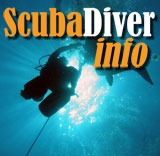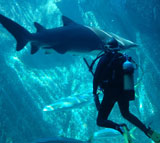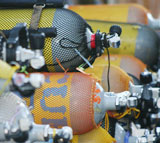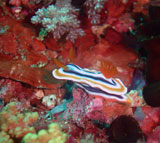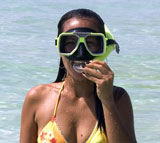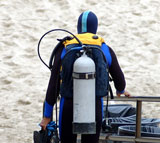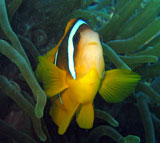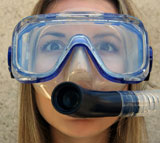Diving masks
by Conrad H. Blickenstorfer
The primary reason why a lot of people don't enjoy swimming, let alone diving, is because they don't like water in their eyes. Sure, you can swim underwater with your eyes open, but not everybody likes the feeling, and our eyes were not designed to see well in water. Some buy inexpensive goggles or masks but quickly give up on them because most leak and break.
For diving, a good mask is absolutely essential. It is the difference between a great diving or snorkeling experience and a miserable one. A good mask fits well, does not leak, provides good vision underwater, and protects the diver's face in case of an accident. A good mask also makes it easy to adjust the pressure inside when ascending and descending.
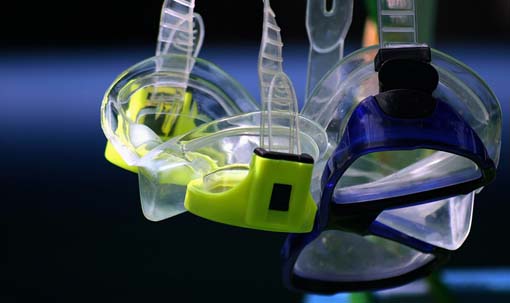
Masks come in many designs, shapes, and colors. All, however, serve the same purpose. That purpose is to provide an airspace in front of the diver's eyes so s/he can see clearly, and also a way to equalize the pressure inside the mask. This means the mask must cover the nose so that the diver can inhale and exhale to adjust pressure. The airspace should be as small as possible because that makes pressure adjustment easier, and also cuts down on the buoyancy of the mask. A really big one can easily be pulled right off the diver's face.
What's the difference between goggles and a mask?
Why do scuba divers wear masks that cover the nose and not just goggles? Goggles seem lighter and handier. The reason is that the nose pocket of a diving mask is needed to compensate for increasing pressure as you dive deeper. The nose pocket allows the diver to blow air into the mask, equalizing the pressure.
What does a diving mask consist of?
That would be a single lens or a lens for each eye made of tempered glass. Toughened, or "tempered," glass is used for the lenses because it is four to six times tougher and because if it breaks, it crumbles into thumbnail size pieces instead of sharp shards. Frames come with either two lenses or a single lens. The choice of one or the other is largely a personal preference. Some feel that double lenses provide a wider field of vision. Also, for those who need glasses,
double lens designs can be ordered with special lenses. Single lens designs generally feel more natural. Some manufacturers also offer different kind of tempered glass for their masks. Riffe's masks can be ordered clear glass, amber for better contrast in low visibility situations, and even mirror that hides eyes and reduces glare.
The skirt is important as it holds out the water. Older and less expensive masks may use neoprene skirts whereas newer 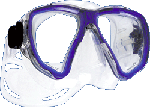 ones use silicone rubber skirts. Neoprene is harder and doesn't hold up well in sunlight and against chemicals such as gas or sunscreen. The surgical grade silicone used in good masks lasts long, seals well, and feels more comfortable. Note that a good mask has a double skirt. The outer one seals against water. The inner one parallels the outer one--except under the nose--and follows face muscle movements. The mask on the right is a Scubapro Premier, a
model with drop-shaped lenses for good downward vision and a clear skirt that some divers prefer for its light, open feeling. ones use silicone rubber skirts. Neoprene is harder and doesn't hold up well in sunlight and against chemicals such as gas or sunscreen. The surgical grade silicone used in good masks lasts long, seals well, and feels more comfortable. Note that a good mask has a double skirt. The outer one seals against water. The inner one parallels the outer one--except under the nose--and follows face muscle movements. The mask on the right is a Scubapro Premier, a
model with drop-shaped lenses for good downward vision and a clear skirt that some divers prefer for its light, open feeling.
Some diving masks have purge valves that allow elimination of water without breaking the seal. 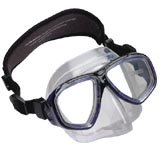 Purge valves are one-way valves, usually integrated into the mask right under the nose, and let you get rid of water by snorting into the mask. Wearers of contact lenses often prefer purge valves because taking off the mask under water may result in the loss of a lens. Some experienced divers contend that a purge valve is not necessary and simply adds cost and complexity. And masks with purge valves are typically higher volume, so the larger amount of water that needs to be eliminated during the clearing process offsets the usefulness of the purge. Finally, a purge valve mask is rendered useless without the tiny silicone diaphragm in the purge, so bring along spares! The mask shown on the right is an Oceanic Ion 2 Purge. Purge valves are one-way valves, usually integrated into the mask right under the nose, and let you get rid of water by snorting into the mask. Wearers of contact lenses often prefer purge valves because taking off the mask under water may result in the loss of a lens. Some experienced divers contend that a purge valve is not necessary and simply adds cost and complexity. And masks with purge valves are typically higher volume, so the larger amount of water that needs to be eliminated during the clearing process offsets the usefulness of the purge. Finally, a purge valve mask is rendered useless without the tiny silicone diaphragm in the purge, so bring along spares! The mask shown on the right is an Oceanic Ion 2 Purge.
The mask retaining strap is made of soft silicone rubber as well. It has a quick release adjustment on each side. The strap also serves as an attachment point for the snorkel. Some divers don't like the way the wide silicone straps in the back can get tangled up in hair, especially when it is long. They may remove the silicone rubber strap and replace it with an elastic fabric/velcro strap with a soft strapwrapper (they usually come in bright colors and often carry dive shop logos and promos).
Just like glasses, most masks have a frame to provide structure  and a mounting point for the lens or lenses. The frame is made of a non-corroding material, usually polycarbonate plastic. Some single lens masks are frameless, using a unique system of assembling the lens and skirt into a mask with reduced weight and volume. The mask shown on the right is Scubapro's Trinidad Frameless 2. and a mounting point for the lens or lenses. The frame is made of a non-corroding material, usually polycarbonate plastic. Some single lens masks are frameless, using a unique system of assembling the lens and skirt into a mask with reduced weight and volume. The mask shown on the right is Scubapro's Trinidad Frameless 2.
Masks come not only in many colors, but also with either opaque or clear silicone skirts. While at first sight the idea of a clear skirt seems a good one, many divers find the extra light and reflections confusing and prefer a black skirt. If you're into underwater photography, an opaque skirt is the only way to go. On the other hand, there are divers who feel dark skirts add to the "tunnelvision" effect of a mask and find that a clear skirts provides a viewing experience closer to that we have without a mask. Below you can see the low-volume Cressi Lince mask. It is available both with a dark and clear skirt, and comes in no less six colors.

There is a large variety of mask designs for all sorts of preferences and purposes. Each of the major vendors carries numerous designs, from plain vanilla to complex and specialized.
What if you need glasses?
Scuba divers need to be able to see and read their instruments at all times, so how do people who wear glasses cope? Obviously you can't wear your regular glasses under a diving mask. One option is contact lenses. Another is getting a mask that can be fitted with optional optical lenses (most masks can be equipped with special lenses made with your prescription), or may even have separate optical windows downward. Many can easily be
equipped with optical glass from -1.5 to -8.0 diopters in .5 increments. Divers who have good vision but need reading glasses may use stick-on reading lenses. Some, like the DIVEOPTX magnifying
lenses, come in many magnifications, are re-usable, and leave no residue. When ordering diving optics, keep in mind that water magnifies by about 33%. If you use, for example, 2.00 diopter reading glasses on dry land, you only need 1.50 or 1.75 underwater.
If you do wear glasses or need reading glasses, do not automatically assume you need glasses underwater. The magnification effect can be significant and you may find that you can read your instruments or dive computer while diving even if you can't on dry land!
For more information on prescription dive masks, read the ScubaDiverInfo article on our experiences here.
How do I select a mask?
A good fit is by far the most important, more so than features, colors, etc. Since everyone's face is different, nothing but trying it one will reveal whether a mask will work for you. So head for the local dive shop and start trying them on.
Many manufacturers label their masks small/medium/large to indicate what they are designed for.
Now get down to business. Move the strap out of the way, fit the mask onto your face, and then inhale just a bit. That should be enough to create a vacuum to hold the mask on your face. If you try on several masks, you'll immediately see how some form a vacuum much better than others. Also make sure the fit is comfortable. And oh, gentlemen, if you wear a beard or moustache, getting a good seal is pretty much impossible.
And keep something else in mind: The design of the mask determines how, and how well, you can see underwater. Less airspace inside the mask makes for better peripheral vision. it also makes it easier to clear the mask of water.
Sharing and storing
Is it okay to share a mask with a friend or loved one? Umm... no. The skirt of good quality diving masks is made of surgical silicone, and that material forms a "memory" of your face. That's why a new mask fits, and seals, better and better after you've used it a few times. Letting someone else use the mask disturbs that memory and can destroy that perfect fit. So don't allow other people to wear a mask that has memorized your face. Next time you wear it it will probably leak!
The memory effect of the silicone skirt is also the reason why a diving mask should always be stored in the case it came in. That way the shape of the skirt is protected.
Slap Straps
One annoying thing about most masks is rubber mask strap. It easily gets twisted and tangled, and it can easily pull your hair. Fortunately, you can inexpensively replace the stock straps with wide neoprene straps that were first introduced by a company named Innovative Scuba Concepts under the "Slap Strap" trademark. Slap Straps cost little and make it much easier to put the mask on. They use velcro and eventually wear out, but they are cheap to replace. Get one. An alternate is to get a variant that fits over the standard rubber strap. Dive shops often sell them, in bright colors, with their logo and contact information.
Specialty masks
Those range from highly professional equipment, such as full face diving masks, to interesting innovations such as a mask with ear muffs to keep water out of the ears and making hearing easier.
Full face masks protect professional and advanced recreational divers in polluted water and from stings, 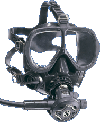 also allow verbal communication, and alleviate cramps from having to bite on a mouthpiece for long periods of time. They are also warmer in very cold water, and the chance of the mask getting knocked off accidentally is much lower. Full face masks are also referred to as "Jack Browne" masks in recognition of the Desco engineer who came up with the protytpe design of a full face mask with an integrated air supply attachment. The model shown on the left is an older Scubapro Full Face Mask. also allow verbal communication, and alleviate cramps from having to bite on a mouthpiece for long periods of time. They are also warmer in very cold water, and the chance of the mask getting knocked off accidentally is much lower. Full face masks are also referred to as "Jack Browne" masks in recognition of the Desco engineer who came up with the protytpe design of a full face mask with an integrated air supply attachment. The model shown on the left is an older Scubapro Full Face Mask.
The ProEar mask, invented by pioneering red Sea diver Howard Rosenstein, 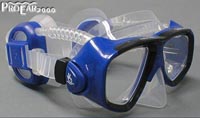 adds a pair of hydrodynamic silicone/plastic cups that envelope the outer ear and form a watertight seal. In addition to keeping the ears dry and facilitating better
hearing, the ProEar mask also makes pressure equalization easier via two thin silicone tubes connecting the mask and the ear cups. It seems almost impossible to achieve a seal over hair, but the company has many enthusiastic testimonials, and the ProEar mask may help those prone to ear infections. We actually met a user who swears by the ProEar. She says the ear cups form a perfect water seal even over hair. adds a pair of hydrodynamic silicone/plastic cups that envelope the outer ear and form a watertight seal. In addition to keeping the ears dry and facilitating better
hearing, the ProEar mask also makes pressure equalization easier via two thin silicone tubes connecting the mask and the ear cups. It seems almost impossible to achieve a seal over hair, but the company has many enthusiastic testimonials, and the ProEar mask may help those prone to ear infections. We actually met a user who swears by the ProEar. She says the ear cups form a perfect water seal even over hair.
Another interesting speciality mask is made by HydroOptix of Culver City, Calif. 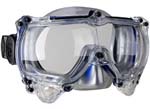 Their Double-Dome technology is geared towards providing true size and true distance perception as well as no distortion. Underwater, flat scuba masks magnify objects, making them appear larger and closer than they really are. This magnification reduces or "hides" more than 75% of what you are actually able to see above water using the same (conventional) dive mask. Yes, a full 75% of our normal above-water field-of-view is blocked by conventional masks once submerged
refraction is factored in. Interestingly, those with perfect 20/20 vision must wear contact lenses to dive with a Double-Dome mask. Their Double-Dome technology is geared towards providing true size and true distance perception as well as no distortion. Underwater, flat scuba masks magnify objects, making them appear larger and closer than they really are. This magnification reduces or "hides" more than 75% of what you are actually able to see above water using the same (conventional) dive mask. Yes, a full 75% of our normal above-water field-of-view is blocked by conventional masks once submerged
refraction is factored in. Interestingly, those with perfect 20/20 vision must wear contact lenses to dive with a Double-Dome mask.
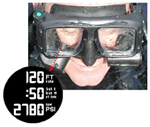 Heads-Up Display mask -- Oceanic worked for years on a mask with an integrated Heads-Up Display (HUD) that lets you see all the data you normally use your gauges and dive computer for floating in front of your eyes! How cool is that? The HUD mask uses a small LCD panel, the necessary optics to make the display appear in front of your eyes, and all the sensors and electronics needed to displays the depth, bottom time, and tank pressure. Oceanic says a consumer version will feature all the information currently displayed in their line of hand-held and wireless dive computers. For the full development story of the Oceanic HUD mask, click here. The air-integrated DataMask costs US$1,499; that's quite a bit but really not much more than some of the more advanced dive computers.
Heads-Up Display mask -- Oceanic worked for years on a mask with an integrated Heads-Up Display (HUD) that lets you see all the data you normally use your gauges and dive computer for floating in front of your eyes! How cool is that? The HUD mask uses a small LCD panel, the necessary optics to make the display appear in front of your eyes, and all the sensors and electronics needed to displays the depth, bottom time, and tank pressure. Oceanic says a consumer version will feature all the information currently displayed in their line of hand-held and wireless dive computers. For the full development story of the Oceanic HUD mask, click here. The air-integrated DataMask costs US$1,499; that's quite a bit but really not much more than some of the more advanced dive computers.
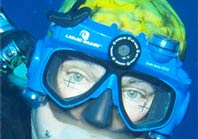 Camera mask -- There are dive masks with cameras built in! This way divers can shoot pictures and take videi, even in high definition, while still having their hands free. The mask shown to the right is from LiquidImage, a company that has a whole range of camera masks, ranging from snorkeling all the way to advanced scuba. The camera mask can also be equipped with dual mask-mounted dive lights that can really make a difference. We have reviewed the LiquidImage scuba mask (see here and love it. The mask itself is as good as any scuba mask, and you don't even feel the camera when you're underwater.
Camera mask -- There are dive masks with cameras built in! This way divers can shoot pictures and take videi, even in high definition, while still having their hands free. The mask shown to the right is from LiquidImage, a company that has a whole range of camera masks, ranging from snorkeling all the way to advanced scuba. The camera mask can also be equipped with dual mask-mounted dive lights that can really make a difference. We have reviewed the LiquidImage scuba mask (see here and love it. The mask itself is as good as any scuba mask, and you don't even feel the camera when you're underwater.
|
